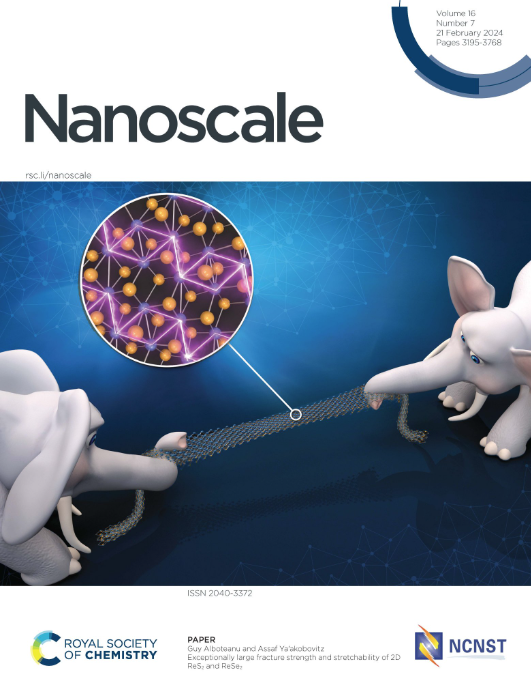通过原子动力学蒙特卡洛模拟控制用于纳米级互连的氮化钽(TaN)阻挡层和氮化钌(Ru)-氮化钽(TaN)组合阻挡层/衬底上的铜形态
IF 5.8
3区 材料科学
Q1 CHEMISTRY, MULTIDISCIPLINARY
引用次数: 0
摘要
电子设备的微型化给后端加工中的金属互连沉积带来了严峻的挑战,因为互连通孔的可用体积越来越小。铜目前用作互连金属,需要阻挡层和衬垫层来防止扩散到硅中,并促进薄膜的顺利生长。然而,这些层占据了本已狭窄的高纵横比互连通孔的关键空间。设计组合式阻挡层/衬垫材料对于优化可用互连体积至关重要。虽然可以通过密度泛函理论(DFT)等第一性原理计算预测薄膜形态,但建立沉积模型以了解金属生长的演变过程并优化阻挡层材料设计和金属沉积却极具挑战性。我们介绍了一项原子动力学蒙特卡洛(kMC)研究,研究铜在作为潜在双功能阻挡层/线材料的 Ru 改性 TaN 上的沉积。利用 DFT 计算的活化势垒,我们预测了铜在这些具有重要技术意义的基底上在生产线后端加工温度下的形态。我们通过分析薄膜粗糙度、岛尺寸、基底暴露、层占用率、薄膜致密性和退火的影响,评估了二维与三维形态和薄膜质量。我们的研究结果表明,掺入 50% Ru 的 Ru 改性 TaN 能显著减少粗糙度和孤岛,促进理想的二维生长。真空退火进一步促进了铜薄膜的平滑,消除了 Ru 改性基底上的空位缺陷,而 TaN 则进一步促进了孤岛的形成。这证明了 Ru-TaN 在优化先进 CMOS 互连的铜沉积方面的潜力,并展示了在一系列基底上进行金属沉积的原子模拟的全新、稳健的方法。本文章由计算机程序翻译,如有差异,请以英文原文为准。
Control of Cu morphology on TaN barrier and combined Ru-TaN barrier/liner substrates for nanoscale interconnects from atomistic kinetic Monte Carlo simulations
The miniaturization of electronic devices poses severe challenges for metal interconnect deposition in back end of line processing due to the decreasing volume available in the interconnect via. Cu is currently used as the interconnect metal and requires barrier and liner layers to prevent diffusion into silicon and promote smooth film growth. However, these layers occupy critical space in the already narrow, high-aspect ratio interconnect vias. Designing combined barrier/liner materials is critical tooptimizingavailable interconnect volume. While film morphology can be predicted from first principles calculations, e.g. Density Functional Theory (DFT), modelling deposition to understand the evolution of metal growth and optimize barrier material design and metal deposition is extremely challenging. We present an atomistic kinetic Monte Carlo (kMC) investigation of Cu deposition on Ru-modified TaN as a potential dual-function barrier/line material. Using DFT-calculated activation barriers, we predict Cu morphology on these technologically important substrates at back end of line processing temperatures. We evaluate 2D vs. 3D morphology and film quality by analyzing film roughness, island size, substrate exposure, layer occupation rate, film compactness and the effect of annealing. Our results show Ru-modified TaN with 50% Ru incorporation significantly reduces roughness and islanding, promoting desired 2D growth. Vacuum annealing further promotes smooth Cu films, eliminating vacancy defects on Ru-modified substrates, while TaN promotes further island formation. This demonstrates the potential of Ru-TaN in optimizing Cu deposition for advanced CMOS interconnects and showcases a new, robust approach for atomistic simulation of metal deposition on a range of substrates.
求助全文
通过发布文献求助,成功后即可免费获取论文全文。
去求助
来源期刊

Nanoscale
CHEMISTRY, MULTIDISCIPLINARY-NANOSCIENCE & NANOTECHNOLOGY
CiteScore
12.10
自引率
3.00%
发文量
1628
审稿时长
1.6 months
期刊介绍:
Nanoscale is a high-impact international journal, publishing high-quality research across nanoscience and nanotechnology. Nanoscale publishes a full mix of research articles on experimental and theoretical work, including reviews, communications, and full papers.Highly interdisciplinary, this journal appeals to scientists, researchers and professionals interested in nanoscience and nanotechnology, quantum materials and quantum technology, including the areas of physics, chemistry, biology, medicine, materials, energy/environment, information technology, detection science, healthcare and drug discovery, and electronics.
 求助内容:
求助内容: 应助结果提醒方式:
应助结果提醒方式:


